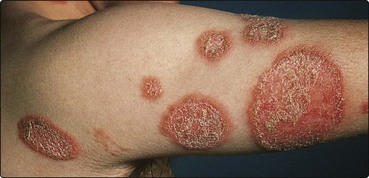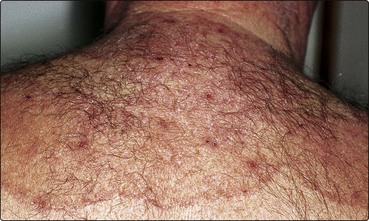Fungal infections
Fungal infection in humans is common and mainly due to two groups of fungi:
These are usually confined to the stratum corneum, but deep mycoses invade other tissues (p. 61). Pityriasis versicolor, due to the yeast Malassezia (previously Pityrosporum ovale) is described on page 42.
Dermatophyte infections
Thirty species are pathogenic in humans. Zoophilic species (transmitted to humans from animals), e.g. Trichophyton verrucosum (Fig. 1), produce more inflammation than anthropophilic (human only) species.

Fig. 1 Tinea corporis.
The infection is due to animal ringworm (T. verrucosum) and shows intense inflammation.
Pathology
Dermatophytes inhabit keratin as branching hyphae, identifiable on microscopy. Skin scrapings, placed on a slide with 10% aqueous potassium hydroxide (to separate the keratinocytes) and a coverslip, are examined microscopically for hyphae (p. 20). The dermatophyte is identified by culturing the scrapings on medium (e.g. Sabouraud’s) for 3 weeks.
Clinical presentation
 Tinea corporis (trunk and limbs). Single or multiple plaques, with scaling and erythema especially at the edges, characterize this presentation. The lesions enlarge slowly, with central clearing, leaving a ring pattern, hence ‘ringworm’ (Figs 1 and 2). Pustules or vesicles may be seen.
Tinea corporis (trunk and limbs). Single or multiple plaques, with scaling and erythema especially at the edges, characterize this presentation. The lesions enlarge slowly, with central clearing, leaving a ring pattern, hence ‘ringworm’ (Figs 1 and 2). Pustules or vesicles may be seen.
 Tinea cruris (groin). This is more common in men and is often seen in athletes (‘jock itch’), who may also have tinea pedis. It spreads to the upper thigh but rarely involves the scrotum. The advancing edge may be scaly, pustular or vesicular. Causative organisms are shown in Table 1.
Tinea cruris (groin). This is more common in men and is often seen in athletes (‘jock itch’), who may also have tinea pedis. It spreads to the upper thigh but rarely involves the scrotum. The advancing edge may be scaly, pustular or vesicular. Causative organisms are shown in Table 1.
 Tinea incognito. Fungal infection can be modified in appearance and spread by the anti-inflammatory effect of a topical steroid.
Tinea incognito. Fungal infection can be modified in appearance and spread by the anti-inflammatory effect of a topical steroid.
 Tinea manuum (hand). Typically, this appears as a unilateral, diffuse powdery scaling of the palm (Fig. 3). Trichophyton rubrum is often the cause. Tinea pedis may coexist.
Tinea manuum (hand). Typically, this appears as a unilateral, diffuse powdery scaling of the palm (Fig. 3). Trichophyton rubrum is often the cause. Tinea pedis may coexist.
 Tinea capitis (scalp/hair). See pages 66 and 114.
Tinea capitis (scalp/hair). See pages 66 and 114.
 Tinea unguium (nails). See page 68.
Tinea unguium (nails). See page 68.
Table 1 Superficial mycoses: causative organisms and differential diagnosis
| Area | Commonest organism | Differential diagnosis |
|---|---|---|
| Body/limbs (corporis) | T. verrucosum, M. canis, T. rubrum |










